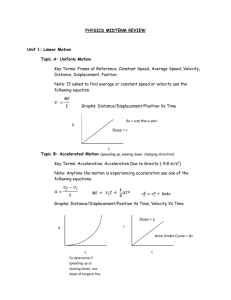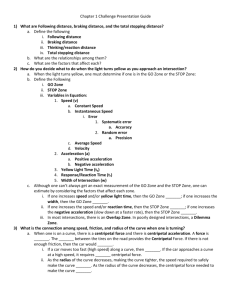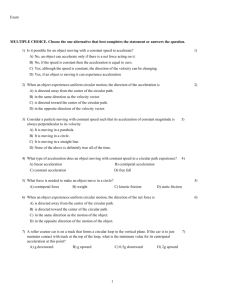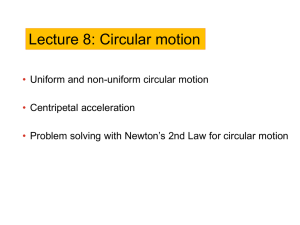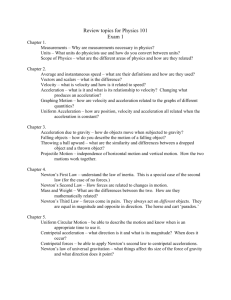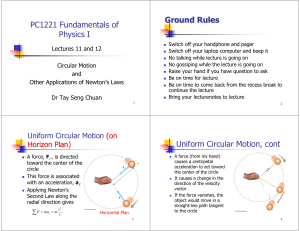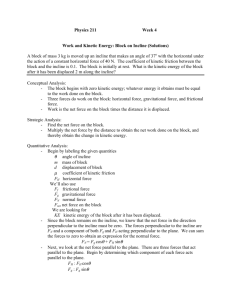Circular Motion Quest Key
advertisement
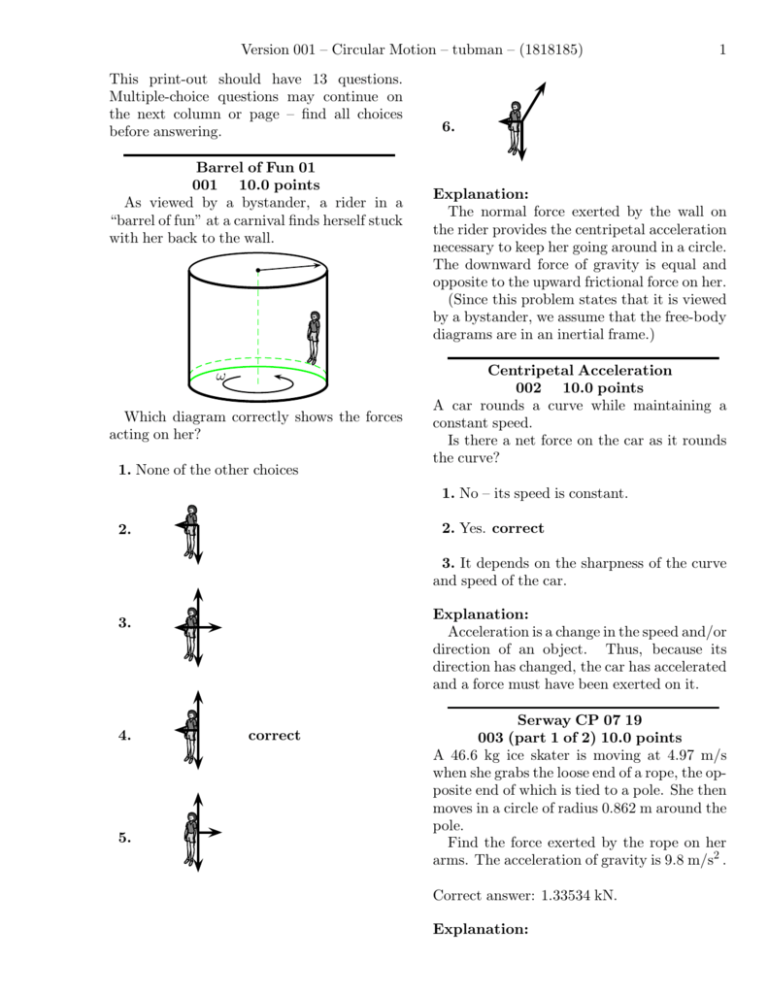
Version 001 – Circular Motion – tubman – (1818185) This print-out should have 13 questions. Multiple-choice questions may continue on the next column or page – find all choices before answering. Barrel of Fun 01 001 10.0 points As viewed by a bystander, a rider in a “barrel of fun” at a carnival finds herself stuck with her back to the wall. ω Which diagram correctly shows the forces acting on her? 1. None of the other choices 1 6. Explanation: The normal force exerted by the wall on the rider provides the centripetal acceleration necessary to keep her going around in a circle. The downward force of gravity is equal and opposite to the upward frictional force on her. (Since this problem states that it is viewed by a bystander, we assume that the free-body diagrams are in an inertial frame.) Centripetal Acceleration 002 10.0 points A car rounds a curve while maintaining a constant speed. Is there a net force on the car as it rounds the curve? 1. No – its speed is constant. 2. Yes. correct 2. 3. It depends on the sharpness of the curve and speed of the car. Explanation: Acceleration is a change in the speed and/or direction of an object. Thus, because its direction has changed, the car has accelerated and a force must have been exerted on it. 3. 4. 5. correct Serway CP 07 19 003 (part 1 of 2) 10.0 points A 46.6 kg ice skater is moving at 4.97 m/s when she grabs the loose end of a rope, the opposite end of which is tied to a pole. She then moves in a circle of radius 0.862 m around the pole. Find the force exerted by the rope on her arms. The acceleration of gravity is 9.8 m/s2 . Correct answer: 1.33534 kN. Explanation: Version 001 – Circular Motion – tubman – (1818185) 2 Correct answer: 7.056 N. Let : m = 46.6 kg , v = 4.97 m/s , r = 0.862 m . and Explanation: Let : The force exerted by the rope is the centripetal force keeping her moving in a circle, so m m v2 (46.6 kg) (4.97 m/s)2 1 kN T = = · r 0.862 m 1000 N = 1.33534 kN . 004 (part 2 of 2) 10.0 points Find the ratio of this tension to her weight. Correct answer: 2.92401. Explanation: M = 0.72 kg and g = 9.8 m/s2 . r v Mg Since the suspended mass is in equilibrium, the tension is T = M g = (0.72 kg) 9.8 m/s2 = 7.056 N . m v2 v2 (4.97 m/s)2 T = r = = W mg rg (0.862 m) (9.8 m/s2 ) = 2.92401 . 006 (part 2 of 3) 10.0 points What is the horizontal force acting on the puck? Correct answer: 7.056 N. Serway CP 07 25 005 (part 1 of 3) 10.0 points An air puck of mass 0.382 kg is tied to a string and allowed to revolve in a circle of radius 0.43 m on a horizontal, frictionless table. The other end of the string passes through a hole in the center of the table and a mass of 0.72 kg is tied to it. The suspended mass remains in equilibrium while the puck revolves. 0.382 kg 0.43 m v Explanation: The horizontal force acting on the puck is the tension in the string, so Fc = T = 7.056 N . 007 (part 3 of 3) 10.0 points What is the speed of the puck? Correct answer: 2.81827 m/s. Explanation: m v2 r s r Fc r (7.056 N) (0.43 m) = v= m 0.382 kg Fc = 0.72 kg What is the tension in the string? The acceleration due to gravity is 9.8 m/s2 . = 2.81827 m/s . Version 001 – Circular Motion – tubman – (1818185) Serway CP 07 20 008 10.0 points A sample of blood is placed in a centrifuge of radius 14 cm. The mass of a red blood cell is 3.1 × 10−16 kg, and the magnitude of the force acting on it as it settles out of the plasma is 2.1 × 10−11 N. At how many revolutions per second should the centrifuge be operated? Explanation: Fc = m ac = m g − Wa Wa = m g − m ac = m(g − ac ) = (43.9 kg) 9.8 m/s2 − 0.034 m/s2 = 428.727 N . Correct answer: 430.22 N. Explanation: At the poles, the rotating velocity is zero, so r = 14 cm = 0.14 m , m = 3.1 × 10−16 kg , and Fc = 2.1 × 10−11 N . Fc = Wa − m g = 0 The centripetal force gives us the angular velocity: v2 Fc = m = m r ω2 r r Fc ω= sm r = Since the centripetal acceleration of a person is inward (toward the Earth’s axis), 010 (part 2 of 2) 10.0 points What is his apparent weight at the poles? Correct answer: 110.71 rev/s. Let : 3 2.1 × 10−11 N (3.1 × 10−16 kg)(0.14 m) 1 rev 2 π rad Wa = m g = (43.9 kg) 9.8 m/s2 = 430.22 N . Car on a Banked Curve 01 011 10.0 points A curve of radius 51.2 m is banked so that a car of mass 1.6 Mg traveling with uniform speed 53 km/hr can round the curve without relying on friction to keep it from slipping on the surface. = 110.71 rev/s . Serway CP 07 49 009 (part 1 of 2) 10.0 points Because of Earth’s rotation about its axis, a point on the Equator experiences a centripetal acceleration of 0.034 m/s2 , while a point at the poles experiences no centripetal acceleration. What is the apparent weight at the equator of a person with a mass of 43.9 kg? The acceleration of gravity is 9.8 m/s2 . Your answer must be within ± 0.1% Correct answer: 428.727 N. Explanation: Let : 1. 6 µ≈ and 0 θ At what angle is the curve banked? The acceleration due to gravity is 9.8 m/s2 . Correct answer: 23.3628 deg. Explanation: Let : ac = 0.034 m/s2 m = 43.9 kg . Mg m = 1.6 Mg = 1600 kg , v = 53 km/hr , r = 51.2 m , and g = 9.8 m/s2 . Version 001 – Circular Motion – tubman – (1818185) 4 d 1000 m 1 hr v = (53 km/hr) 1 km 3600 s = 14.7222 m/s . l θ Consider the free body diagram for the car. In the absence of friction the forces acting on the car are the normal force and the force due to gravity: N θ N cos θ y What is the speed of each seat? x N sin θ Correct answer: 3.47052 m/s. Explanation: In the vertical direction we have mg To keep an object moving in a circle requires a force directed toward the center of the circle; its magnitude is Fc = m ac = m Fx = N sin θ = m i X where T is the tension in the chain. In the horizontal direction we have v2 . r T sin θ = Using the free-body diagram, X T cos θ = m g , v2 r m v2 . r Since and Fy = N cos θ = m g . i Dividing, v2 (14.7222 m/s)2 tan θ = = gr (9.8 m/s2 ) (51.2 m) = 0.431967 θ = arctan(0.431967) = 23.3628◦ . Amusement Park Ride 012 (part 1 of 2) 10.0 points An amusement park ride consists of a rotating circular platform 10.2 m in diameter from which 10 kg seats are suspended at the end of 2.52 m massless chains. When the system rotates, the chains make an angle of 12.3◦ with the vertical. The acceleration of gravity is 9.8 m/s2 . r = ℓ sin θ + d 2 = (2.52 m) sin 12.3◦ + 10.2 m 2 = 5.63684 m , we have p v = g r tan θ q = (9.8 m/s2 ) (5.63684 m) tan 12.3◦ = 3.47052 m/s . 013 (part 2 of 2) 10.0 points If a child of mass 37.4 kg sits in a seat, what is the tension in the chain (for the same angle)? Correct answer: 475.433 N. Explanation: M = 37.4 kg Version 001 – Circular Motion – tubman – (1818185) From the first part we have T cos θ = (m + M ) g (m + M ) g T = cos θ (10 kg + 37.4 kg) (9.8 m/s2 ) = cos 12.3◦ = 475.433 N . 5
